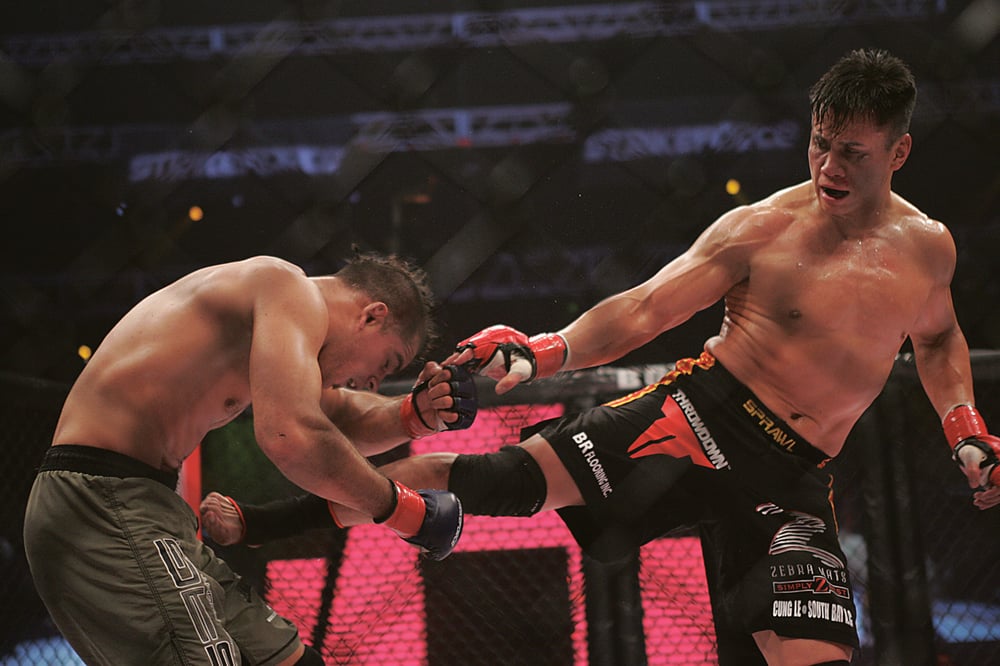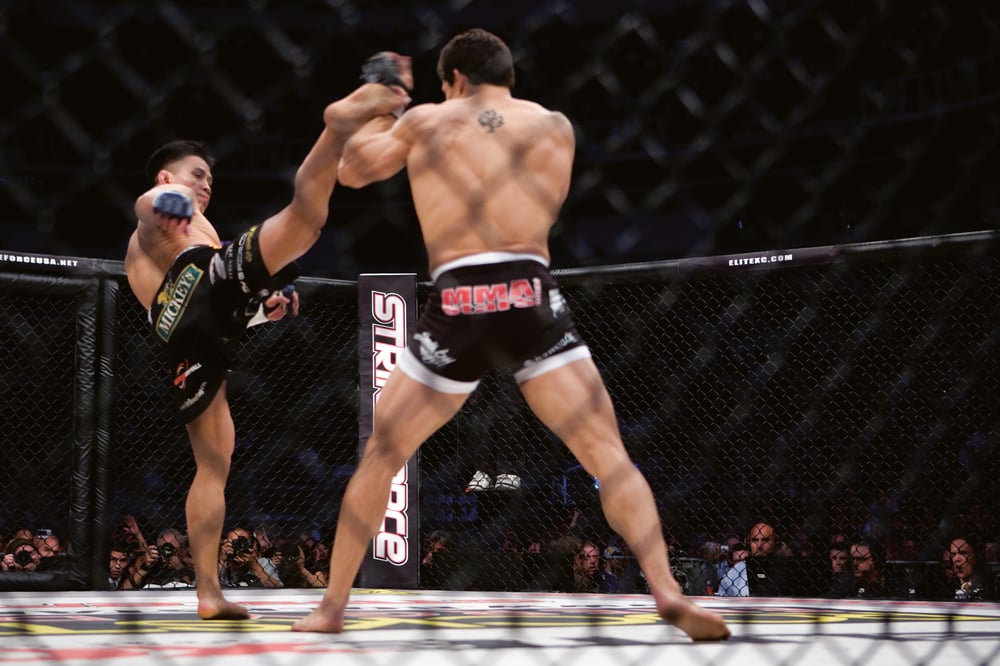
Issue 056
November 2009
The last time Cung Le stepped into the cage he pummeled Frank Shamrock for three straight rounds, breaking the former Strikeforce middleweight champion’s arm in the process. The title was wrapped around Le’s waist, but that was in March of 2008, over 18 months ago. As he appears on cinema screens across the world in big-budget films such as Pandorum, he tells us “I’m not done with fighting”.
Training for a fight is “easy”, says Cung Le. “You train every day for two months, but you’re done in an hour and a half. You come back at night and train for another two hours.” Somehow, the Vietnamese-born kickboxer makes the grueling process fighters go through in anticipation of a big bout sound very, very simple.
Put into perspective, maybe it is easy. After all, Le has just spent eight weeks in Germany, often spending upwards of 14 hours a day on the set of the movie Pandorum. He wasn’t there to make up the numbers – he had a major supporting role in the film, appearing alongside prominent movie stars Dennis Quaid and Ben Foster. Le also insisted upon doing his own stunts, including two-story falls without wires. As if this wasn’t taxing enough, he had to cut to 180 pounds for the role and maintain that weight for two whole months. “I cranked it,” he says. “I put blood and sweat into the project.”
When athletes enter the world of film, they usually do so at the end of their careers. As their sporting glory fades, they seek new life in front of the camera, reinventing themselves as action stars or comedians.
Cung Le differs in that the champion MMA fighter has no intention of hanging up the gloves just yet. “When my number comes back up I’ll step in the cage,”
Cung Le differs in that the champion MMA fighter has no intention of hanging up the gloves just yet. “When my number comes back up I’ll step in the cage,” he says. Until then, he is focused on a budding acting career. Forget the straight-to-DVD B-movies you’re used to from successful martial artists. These are mainstream movies as made by award-winning directors and producers.
In the last 18 months, Le has filmed the new Tekken movie, had a bit-part in the Channing Tatum movie, Fighting, and featured in two Chinese-language films, True Legends (directed by Master Yuen Woo Ping, famous for choreographing The Matrix’s ground-breaking fight scenes) and Bodyguards and Assassins, starring Donnie Yen and produced by Peter Chen. “He’s like the Spielberg of China,” says Le. “He directed The Warlords with Jet Li, which won him Best Director. I really wanted to work with him, and especially Donnie Yen.”
The reason for Le’s lengthy absence from the cage becomes clear when you consider the number of projects he has worked on, but what is surprising to hear is that Le has been involved in movies the entire time he has been fighting MMA. “I had my first MMA fight in 2006, I was doing a movie at the time, and I still fought. All six of my fights, only one or two fights I wasn’t doing movies.”
Cung Le is not a man to rest on his laurels. He began his martial arts career as a ten-year-old studying taekwondo, wrestled in school, and fought as a kickboxer in the early ‘90s, winning multiple national titles. Le grew to prominence in san shou competition, a Chinese form of kickboxing that allows throws and takedowns.
Watching Cung Le fight is like watching an action movie come to life. He lashes out at his opponents with kicks from every possible angle, mixing spinning hook kicks with roundhouses, sidekicks with knees. Observers often remark that his striking style looks like something out of a chop-socky flick. Back when he fought san shou, he would launch his opponents through the air with a big hip toss or leg sweep. It was hard not to imagine how he would fare in MMA.
The critics were silenced in 2006 when Le stepped into the cage for the first time. Fighting in front of 18,000 people in his hometown of San Jose, the pressure was on. Cung was something of a local celebrity, noted for his extremely successful martial arts school and team of fighters. It took him just under four minutes to KO his opponent Mike Altman. His next four opponents fared no better. Brian Warren went down from a flurry of punches and a hard right hand, Jason Von Flue ate a massive kick that split his brow open in less than a minute. Tony Fryklund and Sammy Morgan both made it into the third round, but neither could withstand Le’s devastating strikes.
Cung Le’s defining moment in MMA came when he faced Frank Shamrock. The reigning Strikeforce middleweight champion, Shamrock had been a champ in the UFC and was widely considered one of the sport’s true pioneers. Still young at 34 years old, Shamrock was coming into the fight after a dominant win over Phil Baroni, in which he repeatedly knocked down The New York Badass before choking him unconscious.

Le’s treatment of Shamrock made the former champ’s handling of Baroni pale in comparison. Shamrock was 24-8-1, while Le was a measly 5-0 in comparison (in MMA, of course). Some thought Le should have been trounced by the more experienced champion, but what they didn’t figure is that Le doesn’t lie down for anyone. “I bring an exciting style to the cage. All my fights end in dramatic fashion. I’ve got that warrior spirit, and I’m always ready to do battle. I train like a champion, I win like a champion; and if I lose, I’ll lose like a champion.”
The southpaw fired kick after kick at Shamrock, who made the mistake of trying to stand with the superior striker. In his defense, he had little choice in the matter – try as he might, he could not take Le down. Le landed kick after kick, breaking Shamrock’s right arm in the process. Shamrock quit after the third round, and Le was crowned the champion.
“MMA and martial arts is my foundation, it’s my roots, and I never want to turn my back on that,” says Cung. “It’s a love and passion of mine to teach and train, I’ll never go away from that. I’m 37, right now is the time to be smart about the decisions that I make so I can prolong my career. I’ve got to think of the longevity. I’ve got to take smart fights, and at the same time put food on the table for my kids.” Does this mean that the ‘smart decisions’ mean a permanent shift in focus away from fighting and onto acting? “I feel like I’ve got a couple more fights left in me, and I’m not done with fighting. You’ll see me back in the cage pretty soon,” he says.
With an 18-month break from fighting behind him (the longest in his career as a professional) Le doesn’t want to jump back in at the deep end just yet. As a champion, he would be required to fight a five-round fight, but Le feels it is a step too far to expect him to come back and perform at that level. “I would want a three-round fight first before I jump right back into a five-round fight. For Frank I was ready for five, I’d never gone five, and it went three. You can have a little ring rust when you come back, and it wouldn’t be a smart decision to come back and defend the title right away. Nowadays you can’t say tune-up, I’m just saying I need a three-round fight against one of their contenders, but going 25 minutes is a lot of fighting for someone who has been out for a year and a half.”

As someone at the top of the division, Le is content to allow the up-and-coming middleweights to duke it out for the chance to face him. “I’m lucky to be at the top. Those guys have got their crosshairs pointed at me, Scott Coker [Strikeforce promoter] does an amazing job of putting fights together. Scott doesn’t want to compete with the UFC. Look at everyone who has tried – they’ve crumbled. Scott knows, he’s been promoting a long time, he knows the game and will just put on the best fights he can; Scott has an eye to put the fights together that will cause interest. I’ll let him do his job and when it’s time to get back in the cage, I’ll do my job to make sure I’m in shape and sharp and can put on a show for the fans.”
For Le, his outings in the cage are as much about entertaining his many fans as they are about fighting. Why win by decision if he can win by head kick KO? This is something that he passes along to his fighters, men such as Anthony ‘Rumble’ Johnson and James Terry. Both have vicious, highlight-reel KOs to their name, courtesy of Cung’s tuition and mentoring.
Between training fighters, coaching the US san shou team (Le is one of the most successful coaches in the history of the team, bringing home record hauls of medals from the World Championships) and making and promoting movies, Le has a busy time ahead of him. His legacy as one of America’s greatest martial artists is secure – now he has his sights set on a different challenge.
“I’m very excited to see what MMA fans think of my acting abilities. I didn’t want people going out there and saying, ‘Did you see that MMA fighter? He can’t act!’ I want people to say, ‘Man, that MMA fighter can act, and by the way, he is the Strikeforce middleweight champion!’”
Five traditional MMA’ers
Royce Gracie (Brazilian jiu-jitsu)
Legendary submission artist Royce Gracie was the first man to show the world the effectiveness of ground-fighting, and he did so almost exclusively by using the grappling techniques of his family’s style of jiu-jitsu.
Lyoto Machida (Shotokan karate)
UFC light heavyweight champion Lyoto Machida is an excellent all-round fighter, but his true strength comes from the karate he learned from his Japanese father. Thought karate had no place in the Octagon? Think again.
Chuck Liddell (Kempo karate)
Another karate stylist, although Chuck’s lineage is in American kempo karate (he started training in the art when he was 12). Chuck wrestled in college and fought as a kickboxer, but he still wears the kempo tattoo on his left shoulder.
Karo Parisyan (Judo)
A black belt in judo, Karo Parisyan started training in the art at nine years of age, going on to become a nationally ranked player in the sport. He was one of the first fighters in the UFC to successfully use judo throws in the Octagon.
Fedor Emelianenko (Sambo)
Like all mixed martial artists, the mythical Russian is trained in many styles including boxing and judo, but it is the national sport and martial art of sambo that he claims as his fighting style.
Fight night in, with Cung Le
Grab some popcorn and settle down to a Cung Le movie – look for him in these films!
- Fighting
- Pandorum
- Bodyguards and Assassins
- Tekken











